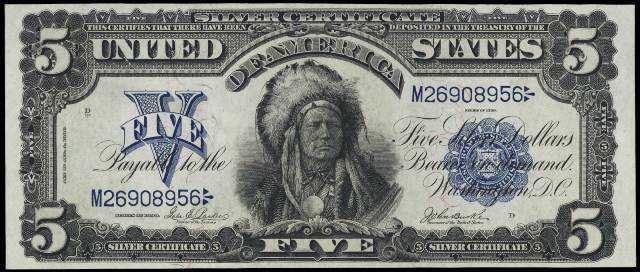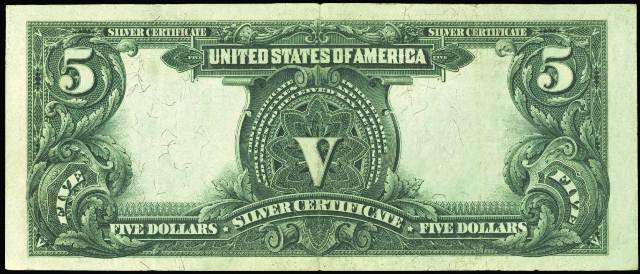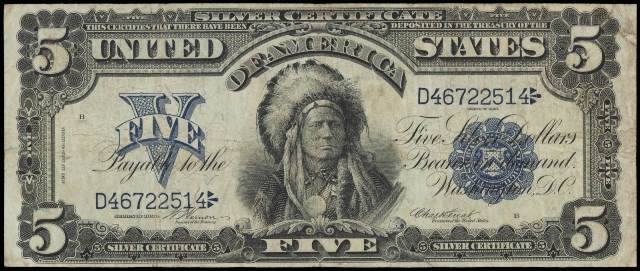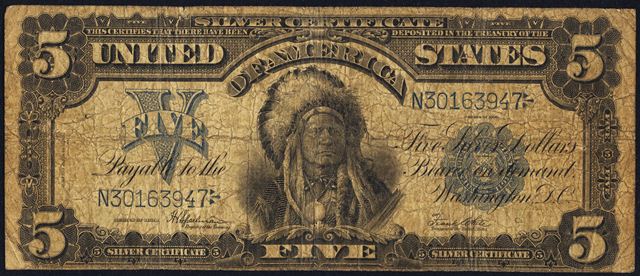Series of 1899 $5 Silver Certificate – Indian Chief Note
History: The five dollar silver certificate has always been one of the most popular denominations to collect. There are several different design types, all of which are popular and affordable in circulated condition. The 1899 $5 silver certificate is especially popular. It features a portrait of a Native American in full headdress. There were three different denominations of silver certificates printed in 1899. The five is the highest denomination and it is also the most expensive of the three types. The 1899 $5 bill was printed up until the early 1920s. The issue is far from rare. However, that does not mean that you can buy this note cheaply. High grade examples can cost well over $1,000.
Nickname: Most paper money dealers and collectors just call this a chief. We have heard other people call it an Indian. This is a situation where people are going to know what you are talking about whether you say chief or Indian. The design is pretty obvious.
Other Facts: The Native American depicted on the 1899 $5 bill is not just a random person. It is actually chief Running Antelope. He was a chief in the Hunkpapa tribe of Lokata Indians. He passed away in 1896, so he never got to see his likeness on United States paper money. This is another example of where people who appreciate American history also tend to like paper money. Another interesting fact is that star replacement notes were first used for 1899 $5 silver certificates (in 1910). In fact, the earliest star note known to exist actually has a solid star symbol instead of the star with a hole in it. So if you find one of those then you are in luck.
Values and Grading: The value of a chief note is mostly determined by its condition. Other things like the serial number and signature combination can be important, but those are rarely a factor. There were eleven different signature combinations used. The Napier Thompson commands a premium in higher grades. You also need to be aware of serial numbers. A serial number under 100 is worth more money than a standard serial number. If the blue serial number on your note begins with a star symbol then it will also be worth more money than a standard issue note. Read below to learn more about how grading affects values.
Choice Uncirculated or Better: There are lots of uncirculated 1899 $5 silver certificates available in today’s market. In fact, we once handled a consecutive pack of 100 notes. Tens of millions of chief notes were printed. Despite being relatively common, high grade chiefs are popular and expensive. A correctly graded UNC chief should cost you $3,000 or more. As the condition gets nicer, then the price gets higher as well.

Chief Notes In Truly Perfect Condition Can Be Worth Thousands Of Dollars
Extremely Fine to About Uncirculated: We see a lot of 1899 $5 silver certificates in about uncirculated (AU) condition. There are probably a lot more AU examples than there are XF examples. AU is of course worth more money though. Something in AU condition should sell for $1,500 or more (but certainly less than $3,000). The note we have pictured is the back of an 1899 $5 bill. As you can see it has a center fold and two other vertical folds. This is typical of what an XF note should look like. There is typically going to be two or three folds, but no more. An AU example should only have one fold. It might not have any folds. It is difficult to show the difference between XF, AU, and UNC notes just with digital scans. You really have to handle them in person to see the small imperfections.

This Exact 1899 $5 Silver Certificate Is Worth About $1,500
Fine to Very Fine: There are hundreds, and maybe even thousands, of 1899 $5 silver certificates in fine or very fine condition. There is a big price difference between something in Fine 12 and Very Fine 35 condition. The fine 12 could be fairly dirty with signs of hard circulation. A Very Fine 35 might only have a handful of very light folds and the paper could otherwise be white and perfect. The price range there is $300 to $1,250. The note we have pictured is slightly dirty and you can tell the paper is fairly soft and used.

This 1899 $5 Silver Certificate Is Worth About $450
Very Good and Lower: It is very easy to buy 1899 $5 bills in heavily circulated condition. They are usually available in bulk quantities. Prices are almost always less than $300. The grade range here would be 1 to 10 (out of 70). At this price point you are typically going to be dealing with buyers who are just looking to fill a hole. Things like a discoloration, stains, tears, etc., might not make a huge difference in the value. We always recommend buying a higher grade, but that is ultimately up to the collector.

Chiefs In This Grade Sell For Under $300
Need an Appraisal or Offer? We are always looking to buy fresh 1899 $5 silver certificates. Please contact us if you have something available. We are especially looking for higher grade examples and star notes. We would be happy to provide a free appraisal and our best offer on any chief note. Just send us an email with pictures of what you have. Sales@AntiqueMoney.com


